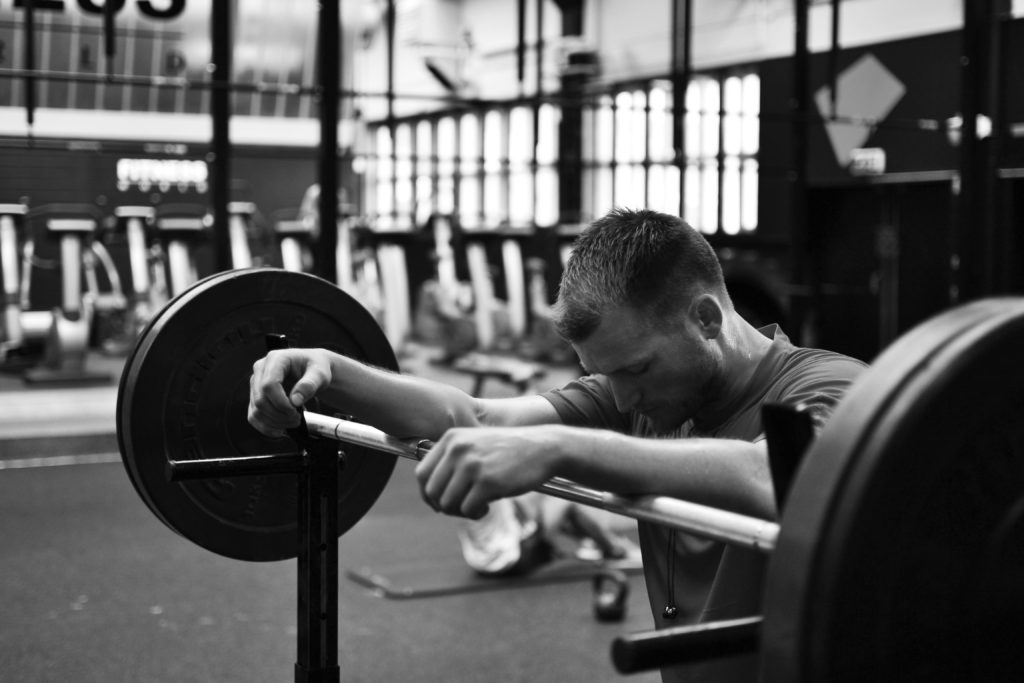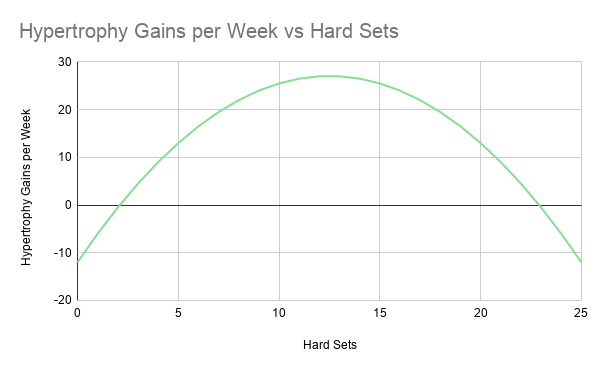Why Would You Train with High Volumes?
High volume training has become popular over the last few years. The main reason being that we now have research to show the more volume you can do and recover from the better your muscle gains. However it’s not a linear relationship. You may be doing 100% more volume for 15-20% better gains. There are issues with research on training volume.
There are many factors that influence how much volume you can recover from. In many cases I think values for the “optimal training volume” that these studies arrive at is an over estimation. The training related factors are covered in depth in the article linked above.
Genetics and recovery factors influence individual training volume tolerance is. These recovery factors mainly consistent of sleep, diet and management of non training related stress.
There are clear benefits of increased training volumes, lets now examine the potential drawbacks of increasing your volume.
Negatives of High Volume Training
More Time Invested in Training
Depending on what stage of your life you’re currently in, this may actually be a positive for you.
Some people just love to train and would increase their training volume and frequency even with no benefit to their results. Sometimes it’s to the detriment of them.
However most people are time constrained and would rather spend the least time they can training to get the maximum gains, or get most of the optimal gains as efficiently as possible.
High volume training doesn’t accomplish this in most cases. Higher training volumes necessitate higher frequencies to actually get the benefits of the higher volumes. Doing 10 sets twice a week would give better results than doing 20 once a week. In the former case the sets are of a higher quality and will be more stimulative on a set by set basis.
Doing more sets takes up more time, obvious I know. This isn’t the only time related factor to consider though.
Increasing training frequency is a significant often understated time investment. Usually an increased frequency will result in more training days. Not only are you training more often, now you have all the other baggage that comes along with a training session.
The commute there and back from the gym. parking, getting changed, pre and post workout rituals such as stretching mobility work, post workout shower etc.
Also each time you train a muscle group you need to do a specific warm up for that muscle/movement pattern. If you’re fairly strong this could take 20-30 minutes for larger muscle groups/bigger compounds. You may even have to wait for equipment.
Numerical Example
I’ll compare two scenarios. I wouldn’t train every muscle with the same volume and frequency, these are just averages. They’re needed to make a numerical example like this work otherwise there are too many variables
- Scenario 1 – You train 4 days a week, train each muscle 2x a week and perform 12 sets per bodypart on average.
- Scenario 2 – You train 6 days a week, train each muscle 3x a week and perform 15 sets a week on average.
We’ll say the workout “baggage” take about an hour (could be longer).
The time taken to do the extra 3 set per week is about 7-8 minutes per body part. Everyone counts muscles differently. Some people would just count the back as one body part, others would divide it into different parts for example.
I think another hour extra for the extra 3 sets per body part is conservative and will take many people even longer.
We also have an extra 2 training days to warm up for. The total warm up time for each session if you’re reasonably strong and have to train half of your body in each session will take at least 30 minutes per session. Again being conservative we’ll put this at an extra hour per week.
Now even with being conservative we’re at an extra 3 hours per week.
In the former scenario we may be spending roughly 10 hours per week between the training and all the baggage that comes with a training session. In the latter we’ve added an extra 30% (being conservative).
This extra 30% time spent in the gym will have an extremely minimal effect on gains. It may not even result in 10% better gains as there isn’t a linear relationship between training volume and gains.
Considering how much free time most people have after life responsibilites such as work and family, this increased training schedule is just not worth the time for most. It’s less efficient and the ROI is very poor.

Lack of Flexibility if Life Gets in The Way
More volume takes longer to recover from. If for whatever reason you can’t make a planned training session and have to move sessions around, other parts of your training will suffer. In this situation you’ll make less gains.
If you’re opting to go for a low training frequency such as once a week, training with high volume can lead to high levels of soreness. If you usually squat 3 days after deadlifts but now have to adjust and this becomes 2 days you could be so sore that it hinders your squat workout.
Or say you’re training with a high frequency and squatting 3x a week and deadlifting 2x a week. Now moving something around will have a significant affect on something else as you may be wiping out an important rest day between training muscles. You’ll go into training sessions with higher amounts of fatigue, negatively affecting your performance.
Psychological Fatigue
Higher training volumes result in more fatigue, both physical and psychological. This will affect all aspects of your life not just training.
I can recall a few instances towards the end of high volume training block where I had a kind of brain fog and sluggishness that didn’t start to go away until mid way through the deload.
My training less effective towards the end of the block as I just didn’t have the neural drive to lift as hard and as intensely as I needed to maximise results. My productivity in other areas of my life also suffered.
I’ve also heard the argument that training more frequently, even twice a day can lead to better sessions. This is because you’re breaking workouts up into smaller chunks so they’re easier to get through.
In my experience, past a certain point this just doesn’t work if you bring some intensity to your training.
I’ve never been able to make more than 5 days a week work well for me, even with moderate volumes. Trust me I’ve tried, I enjoy training. I’ve had periods in the past where I could justify dedicating a large amount of time to training.
There’s something about having a certain number of rest days that allows you to be ready for the hard training. With more than 5 days a week I experience psychological fatigue very quickly. It takes a large effort to get through my final week of training even if I’ve only been through 2 proper weeks.
More Junk Volume
This is something that’s hard to percieve unless you noticeably reduce your volume and can see the difference in the intensity you’re putting in before/after.
Due to the fatigue associated with higher volumes you can put less intensity in and not even realise that you’re doing it.
This just leads to a large amount of junk volume and you’d benefit more from doing less volume and focusing more on intensity with fewer sets.
Higher Injury Risk
When you’re in a higher volume phase it’s extremely easy to put less emphasis on form. You can just try to “get through” the workouts because you have so much to do.
Higher levels of fatigue paired with less of a focus on form is a recipe for injuries. If anything, in higher volume blocks you should be aware of this fact and make sure that you’re focusing MORE on form as you get towards the end of a mesocyle.
Maybe your numbers will be slightly less impressive but higher volume phases shouldn’t be your most strength focused blocks anyway. Its far better to achieve slightly slower consistent progression for years, rather than faster progression for a few months followed by an injury. Rushing will result in far worse long term progress, and now you have an injury to deal with as well that may never fully go away.
Overuse Injuries
Connective tissue takes a lot longer to recover than muscle, often by the time you’re feeling pain significant damage has already been done. Higher volume means you’re stressing that connective tissue more than you would with lower volume. You’re literally subjecting it to stress more often.
The best way to mitigate this is to strategically plan you exercise variation. This way you can get more volume to the desired muscles without hammering the same parts of your connective tissue.
Worse Results?
The relationship between training volume and hypertrophy seems to follow a sort of U-shaped curved. You do more volume and your muscle growth increases up to a point, but it’s not linear, there are diminished returns.
After a certain point your muscle growth plateaus. Then further increases in volume actually results in decreases in muscle growth rates!
This is because you’ve put your body through so much that most of your recovery resources are put towards healing the damage. There isn’t enough to create adaptations.
You can even go past this point and do so much volume that you start losing muscle, this is a fairly extreme scenario.
A big issue I see with advocating very high training volume is that it’s almost impossible to tell exactly where you’re at when you’re near the peak of that curve.
This is especially true when you’re more advanced since your progress is already so slow. If you added 10% more volume would you get better results, worse, how can you tell?
Your progress is so slow that the exact speed can’t be measured. This is due to the confounding factors of being a human who has a life to live. Having a couple days of bad sleep, increase in physical activity, high stress levels from work, just having an off day etc can all influence your numbers.
It’s extremely difficult to standardise these to compare from meso to meso. When the magnitude of improvement is so small the error can just completely mess this up.
You could be slightly past the peak and be getting good results. But you might get BETTER results by DROPPING your volume by 10-20%.
Illusion of Gains From Muscle Swelling
Most people are familiar with the fact that training leads to muscle pumps. It’s a temporary state where a muscle fill with blood and other fluids to become bigger. Generally the higher volumes you use the bigger the pump.
It’s often though that this goes away after a day or so, it largely does but not completely. Compare how a muscle looks after 48 hours of not training it versus a week. It will look less full and flatter in the latter case where there’s completely no pump.
If you’re training with higher volumes and training more frequently your muscle will always be semi pumped. This can give the illusion of muscle gains.
If you switched to a lower volume, lower frequency training plan your muscles would appear to shrink slightly despite no actual muscle loss.
Adaptation to Higher Volumes
The body is great at adapting, after doing high volumes for a few mesos it won’t give the results it did at the start. You can’t keep increasing forever, as explained above at some point further increases actually result in less gains.
At this point it may be in your best interest to take a short low volume period to resensitise yourself to training. Ideally as low as you can go without regressing for a few weeks.
If the idea of this maintenance style training horrifies you, you could also just lower volume slightly and increase intensity by increasing average RPE.
High Volume for Strength Training
Fatigue masks fatigue. In this case fitness is strength. This article is mainly about hypertrophy, the reason being that there isn’t a lot to say about high volume for strength.
High volume can be used to build up the base in more hypertrophy focused phases. It isn’t ideal for strength/peaking phases where the goal is to lift the heaviest.
This is due to the fact that you won’t be able to lift as much as you’re capable of due to high volume adding fatigue that masks strength.
There are ways around this where you can combine both strength and hypertrophy but it doesn’t optimise for either.
Concurrent Strength and Hypertrophy
An article on concurrent strength and hypertrophy training will be out at some point as it’s what many of my clients train for. It’s rare that I see coaches put out content relating to training for both simultaneously.
As a very quick summary.
- Volume should be moderate.
- The week will be asymmetrical in terms of stress.
- The heavy strength days should be at the very start of the week.
- The middle/early end of the week should be more volume focused.
- The end of the week should be easy to recover from so you’re pretty fresh for the heavy days.
- The volume (set count) in each week should be relatively constant. The exception being the end of the final week of the block. You can increase volume here since there’s a deload coming up.
Interested in coaching to take your progress to the next level?



